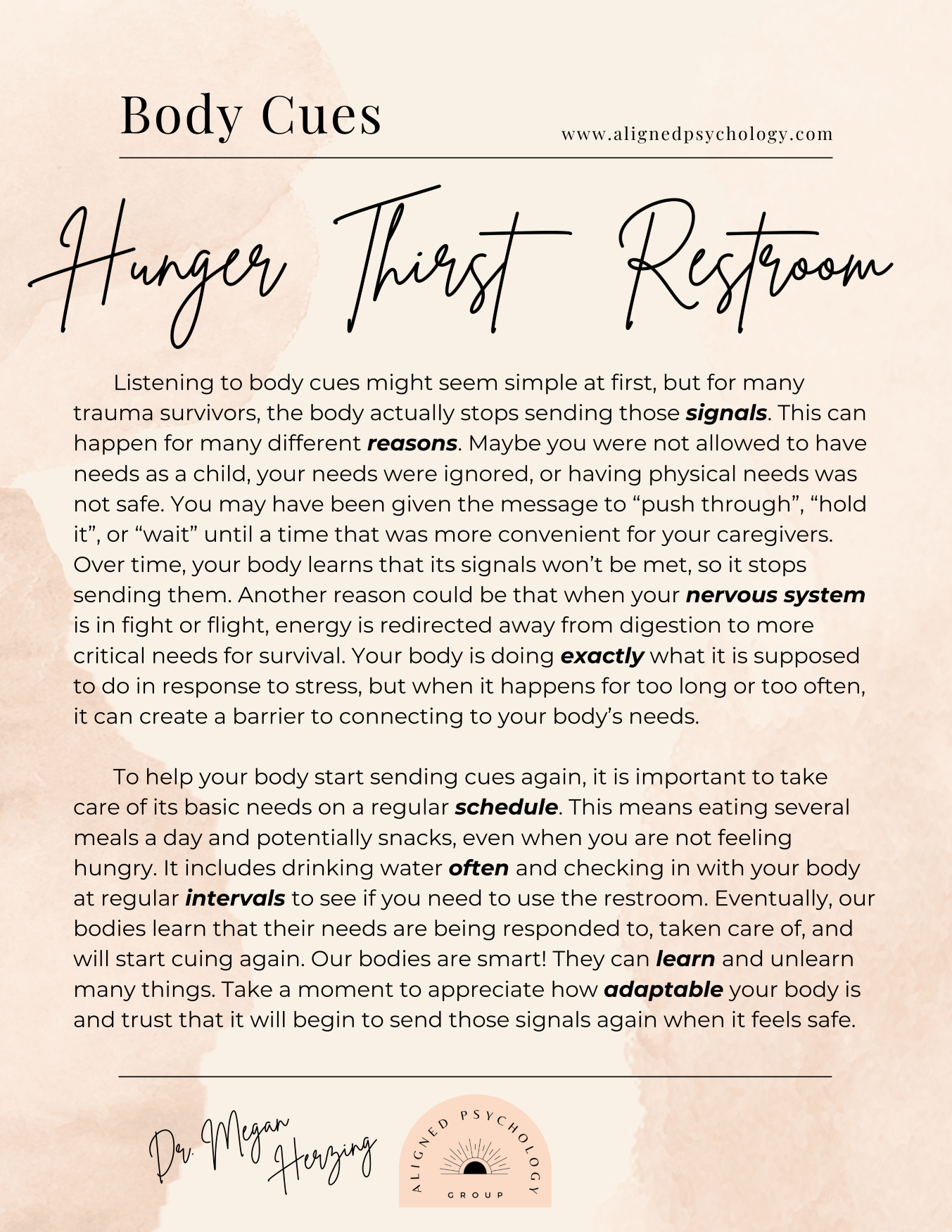Trauma Therapy Homework - Week 7
Week 7: (The Basics)
Listening to Body Cues
Welcome to another installment of our trauma therapy homework series! Today, we’re diving into a practice that’s so simple it often gets overlooked but is foundational to healing: noticing and honoring body cues. These cues—like hunger, thirst, or the need to use the restroom—are the ways our body communicates its basic needs. Yet for many trauma survivors, listening to and responding to these signals can be surprisingly challenging.
If this feels like a tough topic for you, take a deep breath and remember: there’s no shame here. This process is about reconnecting with your body, step by step, and learning to listen to its needs with compassion and curiosity.

What Are Body Cues?
Body cues are the signals your body sends to let you know what it needs. Some of the most common ones include:
- Hunger: The sensation of an empty stomach, growling, or even lightheadedness.
- Thirst: A dry mouth, headache, or a general sense of sluggishness.
- The Need to Use the Restroom: A feeling of fullness in your bladder or bowels.
These cues are your body’s way of saying, “Hey, I need some care and attention.” They might seem small or insignificant, but they’re vital for keeping you healthy and connected to your physical self.
When Trauma Silences Body Cues
For many people, trauma disrupts the natural flow of listening to and honoring body cues. If you weren’t allowed to have needs as a child or if your trauma involved ignoring or overriding your body’s signals, your body might have stopped sending clear cues altogether.
For example:
- If you were taught to “push through” hunger or thirst, your body might suppress those signals.
- If using the restroom was unsafe or inconvenient in your past, you might have learned to ignore that need for hours at a time.
- If your basic needs were consistently unmet, your body might have “given up” on asking.
This disconnection can leave you feeling out of touch with your physical self, unsure of when you’re hungry, thirsty, or needing a break. It’s not your fault—it’s your body’s way of adapting to difficult circumstances.
The Nervous System and Body Cues
When the nervous system is in fight-or-flight mode, it prioritizes survival over everything else. This can have a profound impact on body cues like hunger, thirst, and the need to use the restroom. When your nervous system is in fight/flight, your body directs energy away from digestion and other non-essential functions. This might explain why you don’t feel hungry during a stressful day or forget to drink water when you’re anxious. Similarly, you might not notice the need to use the restroom until it becomes urgent. Understanding this connection can help you approach these challenges with compassion. Your body isn’t “broken”—it’s doing exactly what it’s designed to do in response to stress. The good news is that by practicing awareness and care, you can help your nervous system shift into a calmer state where it feels safe to tune into these cues again.
Listening to Body Cues as a Foundational Practice
Honoring basic body cues is an important first step in reconnecting with your body. When you start to notice and meet these needs, you’re sending a powerful message to yourself: “I hear you, and I will take care of you.” This practice builds trust between you and your body. It also lays the groundwork for listening to deeper needs, like emotional boundaries or desires for connection. If you can learn to honor your body’s signal for a glass of water, you’re taking the first step toward honoring its need for rest, safety, or joy.

Rebuilding the Body’s Ability to Cue
If your body has stopped sending clear signals for hunger or thirst, it might feel overwhelming to start this process. That’s okay—it’s not about perfection, but practice. One helpful strategy is to get ahead of your needs by creating a routine.
For example:
- Hunger: Eat meals or snacks at regular intervals, even if you’re not sure you’re hungry. This can help your body relearn what it feels like to be nourished.
- Thirst: Keep a water bottle nearby and take small sips throughout the day. You don’t have to wait until you feel parched to hydrate.
- Restroom Breaks: Schedule breaks to check in with your body, even if you’re not feeling an urgent need.
Over time, your body can rebuild its ability to cue you naturally. Be patient with yourself—it’s a process, not a quick fix.
The Role of Mindfulness
Mindfulness is a key part of this practice. By tuning into your body’s sensations, you can start to notice subtle cues before they become overwhelming. For example:
- Pay attention to the first signs of thirst, like a dry mouth or slight fatigue.
- Notice when your stomach feels empty or your energy dips, even if you’re not feeling ravenous.
- Check in with your body periodically to see if it needs a restroom break.
These small moments of awareness help you reconnect with your physical self and build a stronger relationship with your body.

Addressing Shame and Trauma
If you’ve struggled to meet your basic needs, it’s important to approach this work with self-compassion. There’s no shame in finding this difficult—it makes sense given the impact of trauma.
Try reframing any critical thoughts you have about yourself. Instead of saying, “Why can’t I just drink water like a normal person?” try, “It’s okay that this feels hard. I’m learning to take care of myself in a new way.” Remember, this is a practice. It’s not about doing it perfectly but about showing up for yourself, one small step at a time.
When Eating Disorders Are Involved
It’s important to note that if you’re dealing with a diagnosable eating disorder, this work requires specialized support. Eating disorders involve complex psychological and physical factors that go beyond the scope of this practice. If this resonates with you, consider reaching out to a therapist or specialist trained in eating disorder recovery.
The Long-Term Practice of Listening to Body Cues
Listening to your body is not a one-time task—it’s a lifelong practice. As you continue your trauma healing journey, you’ll find that honoring these basic needs becomes a foundation for deeper work. By reconnecting with your body in this way, you’re creating a sense of safety and trust that can ripple into other areas of your life. You’re telling your body, “I’m here, I’m listening, and I will take care of you.”
Small Steps, Big Impact
If you’re just starting out, remember that small steps can lead to big changes. Begin by checking in with your body a few times a day. Ask yourself:
- Am I hungry?
- Am I thirsty?
- Do I need to use the restroom?
Over time, these check-ins will become second nature, and your body will start to trust that you’re paying attention.
A Gentle Reminder
This practice is about reconnecting, not perfection. Some days, you might forget to check in with your body or struggle to meet its needs. That’s okay—it’s all part of the process. Be kind to yourself and remember that every small effort counts.
FREE Downloadable Handouts
Click this
LINK
for free access to downloadable PDFs from the Trauma Therapy Homework Series. You’ll be directed to my Google Drive folder, where you can explore all the handouts created so far. You can choose between a digital format for easy viewing on your device or a printable version if you prefer a hard copy.
Here is a preview of this week's handout! Click the link above to get your own free pdf copy.


ABOUT THE AUTHOR
Dr. Megan
Megan Herzing PsyD, Licensed Professional Clinical Counselor, specializes in trauma therapy and creating a safe, supportive space for healing. She integrates evidence-based modalities, including EMDR, Internal Family Systems (IFS), somatic therapy, and Emotionally Focused Therapy (EFT), to address the mind-body connection and empower clients on their journey to wellness. With extensive experience treating complex PTSD, anxiety, attachment injuries, and dissociation, she believes in the power of self-compassion and authentic connection to facilitate lasting change. Drawing from her own healing journey, she brings empathy and lived experience to her work, honoring each client’s unique path toward growth and resilience.
Thank you for being part of a community of humans that deeply cares about healing.
We are honored that you stopped by and hope our resources will continue to bring value to your life.
We are accepting new clients in California, and referrals are always appreciated.












